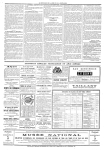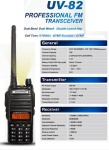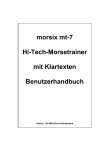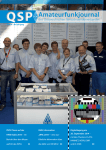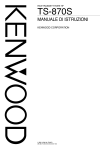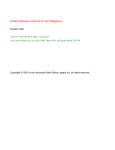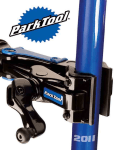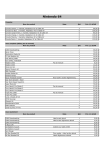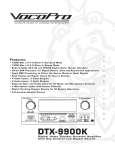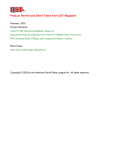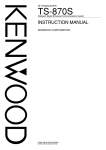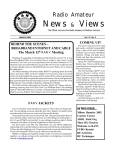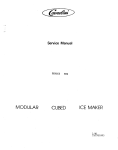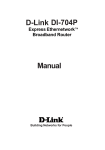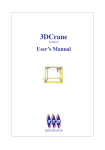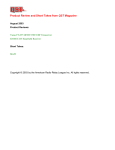Download Kenwood TS-870S MF/HF Transceiver
Transcript
Product Review Column from QST Magazine February 1996 Kenwood TS-870S MF/HF Transceiver MFJ-9420 20-Meter SSB Travel Radio JPS ANC-4 Antenna Noise Canceller Copyright © 1996 by the American Radio Relay League Inc. All rights reserved. Product Review Edited by Rick Lindquist, KX4V • Assistant Technical Editor Kenwood TS-870S MF/HF Transceiver Reviewed by Larry Wolfgang, WR1B Senior Assistant Technical Editor With the introduction of the TS-870S, Kenwood helps usher in a new era in Amateur Radio equipment design. As do the latest offerings from ICOM and Yaesu, Kenwood’s newest MF/HF transceiver includes digital signal processing (DSP) at IF, but with a difference. Kenwood’s competitors take the belt-and-suspenders approach and couple crystal filters (both standard and optional) with DSP on their latest radios, but the TS-870S requires no additional crystal filters to supplement its DSP. It’s the first radio in its class to make that claim. To better understand how the TS-870S implements DSP at HF, see the sidebar “DSP in the Kenwood TS-870S.” Features The TS-870S’s attractive but no-nonsense front panel has the complement of controls you would expect on any full-featured HF rig. But, not all of this radio’s goodies are obvious at first glance. The prominent main tuning knob has a softrubber grip that provides a comfortable feel and a handy finger depression to spin up or down the band. You can set the tuning steps to 5 or 10 kHz per revolution. The FINE tuning button divides this value by 10 when it is turned on, but you cannot display the 1 Hz units to go along with the fine tuning steps. With the small tuning steps, the radio sounds almost “analog” as you tune. None of that digital warbling as the VFO changes frequency! Two groups of four controls apiece (some of them concentric) flank the tuning knob and give ready access to the most-used functions. Better yet, the knobs and associated pushbuttons are substantial enough for even the most fumble-fingered ops to get a grip on them. To the left of the main tuning knob, one set of concentric controls adjusts the builtin electronic keyer speed and AGC attack speed. Turning the AGC knob fully counterclockwise turns off the AGC; there is no detent or other tactile response to let you know when the AGC is off, so you’ll have to look on the display for the red AGC legend above the main frequency readout. Other concentric controls in this group set the speech processor and monitor volume levels, adjust CW, AM or FSK carrier level (or SSB output with the speech processor on), set VOX delay, and adjust microphone gain and power output level. Convenient pushbuttons just above these knobs select the transmit metering function (options are ALC, SWR, compression level and output power) and activate the speech processor and monitor function. The right-hand group of controls includes single-knob controls for RIT/XIT and M.CH/VFO.CH (to change the memory channel or VFO channel), plus concentric controls to set AF or RF level and NB (noise blanker) and SQL (squelch). A CLEAR pushbutton quickly zeros the incremental tuning. As you adjust the RIT, the main frequency display also changes to show the actual receive frequency. The display window conveys plenty of information about the radio’s operating status. Is the AGC on? How about the speech processor? The automatic antenna tuner? All these questions and more are easily answered at a glance. For example, one spot in the display window shows DSP filter high or low-frequency limits for phone modes, filter bandwidth for FSK and filter center frequency or bandwidth for CW. This information shares display space with RIT or XIT tuning increment data, as well as with the transmit frequency in split. The left side of the display window is a digital LCD representation of an analog Bottom Line The first DSP transceiver without standard or optional narrow crystal IF filters, the TS-870S offers fine receive and transmit audio, noteworthy selectivity and comfortable controls. A snazzy computer-control program and interface are standard. meter—complete with an arc. In receive, the top of the display is an S meter. In transmit, the same segments indicate output power. In receive, the lower portion of the display graphically indicates current filter bandwidth and relative frequency shift. This portion of the display lacks numbers, so you can’t tell the exact filter settings. For that information, you’ll have to look at the right side of the display window (and you may have to first turn the appropriate filterselect knob to activate the readout). In transmit, this same meter section displays SWR, ALC or speech compression level. Turning on the P HOLD menu selection holds peak readings on both bar graphs for about 2.5 seconds. Most users liked the display window and its colorful legends. The bright, white main display numerals are about a half-inch high and easy to read. Red labels above the frequency display indicate active functions, such as AGC , MONItor and speech PROCessor. Yellow labels below the frequency display indicate the active mode. One reviewer commented that the unlighted LED segments remain distractingly visible behind the display window lens. A darker display-window lens could lesser the effect. The ANT button selects between two rear-panel antenna connectors. ATT UP and DOWN buttons select either 0, 6, 12 or 18 dB of receive attenuation. AIP (Advanced Intercept Point)—also available with the touch of a button—helps to reduce intermodulation distortion by throttling back the sensitivity. On a band crowded with strong signals, you’ll likely want to leave AIP on. Getting Around with the ’870S The ’870S has two VFOs plus 100 February 1996 71 Table 1 Kenwood TS-870, serial no. 70500128 Manufacturer’s Claimed Specifications Frequency coverage: Receive, 100 kHz-30 MHz; transmit, 1.8-2; 3.5-4; 7-7.3; 10.1-10.15; 14-14.35; 18.068-18.168; 21-21.45; 24.89 -24.99; 28-29.7 MHz. Modes of operation: USB/LSB, CW, AM, FM, FSK Power requirement: Receive, 2 A (no signal); transmit, 20.5 A (max). Receiver SSB/CW sensitivity, bandwidth not specified, 10 dB (S+N)/N: 100-500 kHz, ≤1 µV; 500 kHz1.7 MHz, ≤4 µV; 1.7-24.5 MHz, ≤0.2 µV; 24.5-30 MHz, ≤0.13 µV. AM sensitivity, 10 dB (S+N)/N, bandwidth not specified: 100-500 kHz, ≤2 µV; 0.5-1.7 MHz, ≤32 µV; 1.7-30 MHz, ≤2 µV. FM sensitivity, 12 dB SINAD: 28-30 MHz, ≤0.25 µV. Blocking dynamic range: Not specified. Two-tone, third-order IMD dynamic range: Not specified. Third-order input intercept: Not specified Second-order intercept point: Not specified FM adjacent channel rejection: Not specified FM two-tone, third-order IMD dynamic range: Not specified S-meter sensitivity: Not specified Squelch sensitivity: Not specified Receiver audio output: 1.5 W at 10% THD into 8 Ω. IF/audio response: Not specified. Notch filter depth: 40 dB or more. Spurious and image rejection: 80 dB or better. IF rejection: 80 dB or better. Measured in the ARRL Lab Receive, 30 kHz to 30 MHz; transmit, as specified As specified. Receive, 2 A (no signal); transmit, 16.5 A (max), tested at 13.8 V. Receiver Dynamic Testing Minimum discernible signal (noise floor), 400 Hz WIDTH and 700 Hz SHIFT: Preamp off Preamp on 1.0 MHz –108 dBm –117 dBm 3.5 MHz –131 dBm –141 dBm 14 MHz –129 dBm –139 dBm 10 dB (S+N)/N, 1-kHz tone, 30% modulation, 6 kHz WIDTH: Preamp off Preamp on 1.0 MHz 35 µV (–76 dBm) 11 µV (–86 dBm) 3.8 MHz 2.3 µV (–100 dBm) 0.7 µV (–110 dBm) For 12 dB SINAD, 14-kHz bandwidth: Preamp off Preamp on 29 MHz 0.9 µV (–108 dBm) 0.16 µV (–123 dBm) Blocking dynamic range, 400 Hz WIDTH: Preamp off Preamp on 1.0 MHz 128 dB* 124 dB 3.5 MHz 127 dB* 124 dB 14 MHz 127 dB 123 dB Two-tone, third-order IMD dynamic range, 400 Hz WIDTH : Preamp off Preamp on 1.0 MHz 83 dB 89 dB 3.5 MHz 99 dB 95 dB 14 MHz 97 dB 95 dB Preamp off Preamp on 1.0 MHz +17 dBm +17 dBm 3.5 MHz +18 dBm +2 dBm 14 MHz +16 dBm +4 dBm Preamp off, +63 dBm; preamp on, +63 dBm. 88 dB at 20 kHz channel spacing (29 MHz). Preamp off, 84 dB; preamp on, 79 dB at 20 kHz channel spacing (29 MHz). S9 signal at 14 MHz: preamp off, 176 µV; preamp on, 50 µV. At threshold, preamp on: FM, 0.03 µV; SSB, 1.3 µV. 2.4 W at 10% THD into 8 Ω. Range at –6 dB points, (band width): CW-N (400 Hz WIDTH , 700Hz SHIFT): 489-906 Hz (417 Hz); CW-W (1000 Hz WIDTH , 700 Hz SHIFT ): 195-1203 Hz (1008 Hz); USB-W ( LO=300 Hz, HI=3000 Hz): 230-2988 Hz (2758 Hz); USB-N (LO =400 Hz, HI=1800 Hz): 391-1804 Hz (1413 Hz); LSB-W (LO=300 Hz, HI=3000 Hz): 225-2967 Hz (2742 Hz); LSB-N ( LO=400 Hz, HI=1800 Hz): 386-1798 Hz (1412 Hz). As specified. Preamp off, 98 dB; preamp on, 114 dB. Preamp off, 115 dB; preamp on, 124 dB *. Transmitter Transmitter Dynamic Testing Power output: SSB, CW, FSK, FM, 100 W (max), CW, typically 113 W (max), <1 W (min); SSB, 118 W (max); <1 W (min), 20 W or less (min), continuously adjustable. AM, 25 W varies slightly from band to band. AM, typically 24 W (max), (max), 20 W or less (min), continuously adjustable. <1 W (min). FM, typically 109 W (max), 9 W (min). Spurious-signal and harmonic suppression: 60 dB or more. <60 dBc on all amateur bands. Meets FCC requirements for spectral purity. SSB carrier suppression: 50 dB or more. As specified. Undesired sideband suppression: 50 dB or more. As specified. Third-order intermodulation distortion (IMD) See Figure 1. Expanded Product Review Test Results Report Available products: Not specified. The ARRL Laboratory offers a 30-page test result report on the TS-870S that gives in-depth, detailed technical data on the CW keyer speed range: 6-60 wpm. As specified. transceiver’s performance, outlines our test methods and helps CW keying characteristics: Not specified. See Figure 2. you to interpret the numbers and graphs. Transmit-receive turnaround time (PTT release to S9 signal, 14 ms. The report also includes spectral purity charts and receiver 50% audio output): Not specified. sensitivity figures for all bands, all CW keying waveforms (not just worst-case) and other facts to help you make an informed Receive-transmit turnaround time (“tx delay”): 15 ms. buying decision. The report even includes a summary of how Composite transmitted noise: Not specified. See Figure 3. this radio stacks up with similar, previously tested units. Size (height, width, depth): 4.7×13×13 inches; weight, ≈25 pounds. Request the TS-870S Test Result Report from the ARRL Technical Department at $7.50 for ARRL members and $12.50 Note: Dynamic range measurements were made at the ARRL Lab standard for nonmembers, postpaid. signal spacing of 20 kHz. *Measurement was noise-limited at the value indicated. 72 February 1996 Figure 1—Worst-case spectral display of the TS-870S transmitter during two-tone intermodulation distortion (IMD) testing. The third-order product is approximately 32 dB below PEP output, and the fifth-order product is approximately 47 dB down. The transceiver was being operated at 100 W PEP output at 14.2 MHz. memory channels to make bandhopping and frequency swapping a breeze. Unlike its DSP competitors, the ICOM IC-775DSP or the Yaesu FT-1000MP, the Kenwood TS-870S does not have dual receive capability. You can transmit or receive on either VFO or a memory channel, however. Press the appropriate buttons in the RX and TX columns to the right of the MODE buttons to make a selection. A small LED lights in each active button. A single memory channel can store separate transmit and receive frequencies as well as mode information. The inability to store filter settings in any memory channel or band register was a common complaint from reviewers, however. It seems odd in a radio this sophisticated that you can’t save a particular filter setting with a certain frequency, but the radio does remember what filter setting you used last with each mode. UP and DOWN buttons let you switch bands in sequence or (with the 1MHZ button activated) change frequency in 1-MHz steps instead. Additionally, a ten-key, multifunction keypad allows direct frequency entry, as well as storing memory data, selecting scan functions and controlling the memory keyer features. In VFO mode, you use the M.CH/VFO.CH control to make large frequency excursions within a band in steps of 1, 5 or 10 kHz (menu settable). For split-frequency operation you simply select one VFO (or memory channel) for receive and the other VFO (or memory channel) for transmit. Or you can program a memory channel with both frequencies. If you select different VFOs or memory data for transmit and receive, you press and hold the TF-SET button and use the main tuning knob to set your transmit frequency. One reviewer, who was used to the typical “split” button, found this a bit confusing. It does take getting used to. The Figure 3—Worst-case spectral display of the TS-870S transmitter output during composite-noise testing. Power output is 100 W at 3.5 MHz. The carrier, off the left edge of the plot, is not shown. This plot shows composite transmitted noise 2 to 22 kHz from the carrier. Figure 2—CW keying waveform for the TS-870S in the semi-break-in mode showing the first and second dits. The upper trace is the actual key closure; the lower trace is the RF envelope. Horizontal divisions are 10 ms. The transceiver was being operated at 100 W output at 14.2 MHz. right side of the display shows the transmit frequency and the word SPLIT in small red letters above it. There is no other indication. One contest group that used the radio liked the fact that the ’870S displayed both receive and transmit frequencies but felt it was too easy to transmit on the wrong frequency. Would You Like a Menu? As we’ve suggested, all the ’870S’s features are not obvious at first glance. They’re “hidden” within a menu system that our review team found easy to use. The MENU button provides access to dozens of userdefinable operating parameters, while the M.CH/VFO.CH button selects the appropriate menu item. Two identical menu banks (68 items each) let you define two completely different sets of operating conditions! This is useful for operators who want the radio to perform one way for contesting or DXing, but yet another for rag chewing or operating digital modes. Ham families using the same radio also might find the two menu banks helpful. You’ll want to have the manual at hand as you make your menu selections—at least at first—because the abbreviated word display can be a bit cryptic. Among many other things, the menus let you set or adjust AGC release times for various modes, CW rise and decay times, CW pitch, speech processor frequency response, panel brightness and various DSP parameters. DSP Goodies Four pushbuttons along the upper righthand side of the front panel access the radio’s DSP functions: AUTO NOTCH , BEAT CANCEL, N.R. and TX EQ. The first three are adaptive filters that can identify various interfering signals or noise and modify their filtering characteristics based on the particular noise or interference. (You can switch between SPAC or Line Enhance using a menu selection.) Auto notch only works in SSB mode. This DSP filter identifies interfering tones in the receiver passband and attenuates them. Beat cancel works in both SSB and AM, and is similar to the auto notch filter, but can be more effective for some types of tones. Some reviewers lamented the lack of beat cancel or manual notch for CW. ARRL Lab tests found beat cancel was more effective against multiple heterodynes than auto notch, which only worked well against a single heterodyne. The DSP noise reduction system operates in any mode and effectively reduces random background noise. It’s a bit like an analog noise blanker (the TS-870S has one of those, too), but it seems more effective February 1996 73 than the typical noise blanker, which is best at combating pulse-type noise. Some reviewers were disappointed the noise reduction was not front-panel adjustable, as it is on competing transceivers as well as on many add-on DSP boxes. A menu choice lets you adjust the optimal correlation time for best reception using NR. The TX EQ button lets you apply highfrequency boost, bass boost or comb filtering to your transmitted phone signal according to a menu setting. Other menu settings also let you tweak transmitted audio characteristics. In other words, you can tailor your transmitted audio characteristics to better match your voice, microphone frequency response and room acoustics. Reviewers got good audio signal reports during on-air testing. The transmitted audio did not seem distorted even with 10 dB of speech compression cranked in. As expected, the processor did add extra “punch” to the signal. Now to the heart of the matter, the two small knobs— LO/WIDTH and HI/SHIFT — that adjust the DSP filter settings. For phone reception, the LO/WIDTH knob selects the low-frequency cutoff and the HI/SHIFT knob selects the high-frequency cutoff. On CW and FSK the LO/WIDTH knob selects the bandwidth, while the HI/SHIFT knob sets the IF shift in CW. But watch out! Using the menu, you can change CW pitch, or offset, and if you select a narrow filter bandwidth and adjust the IF shift, it’s possible to move the received signal clean out of the passband! For example, if CW pitch is set to 500 Hz and the bandwidth is 100 Hz, with the IF shift at 700 Hz you won’t be able to tune the received signal for zero beat. All reviewers liked the ability to easily and quickly adjust DSP filter characteristics. Several commented on the operation of these controls. Both give positive tactile feedback—you can feel them “click” as you rotate them, each click representing another step in the DSP filtering. These steps seem optimal for SSB, but, at times, too large for other modes, where several reviewers longed for finer control. For example, you can select CW filter bandwidths of 1000, 600, 400, 200, 100 and even 50 Hz. (In FSK, available bandwidths are 1500, 1000, 500 or 250 Hz.) At times one bandwidth seemed too wide and the next one too narrow. While running RTTY, for example, I would have preferred a bandwidth somewhere between 500 and 250 Hz, especially while tuning for stations. CW operators expressed similar sentiments. A peek at the Service Manual sheds some light on what happens inside the radio when you turn these knobs, and perhaps offers an explanation for the “digital” steps. The radio’s microprocessor selects IF filter combinations based on the LO/WIDTH and HI/SHIFT settings. In addition, the microprocessor sends control signals to the PLL and DDS local oscillator circuits. By changing the LO frequency, the signal is shifted 74 February 1996 so the high and low-frequency edges of the combined filter response reduce the effective bandwidth. Kenwood calls this technique “slope tuning.” Purely from an operating point of view, our reviewers would have preferred to have the filters continuously tunable, in an “analog” fashion. But, Kenwood’s implementation virtually demands a limited number of digital steps. You may have to “twiddle” the two knobs—and adjust the AGC time constant—to obtain the best performance. But, this design means that strong signals close to your desired receive frequency, especially on CW, may cause some blocking. Turning on AIP and adding some attenuation may help. I didn’t experience any interference that couldn’t be acceptably reduced using the TS-870S’s various adjustments. On the other hand, tests in the ARRL Lab confirmed that strong, close-in signals could produce troublesome IMD and degrade dynamic range in the TS-870S. Our in-house receiver guru, Dave Newkirk, WJ1Z, asserts that Kenwood’s filtering scheme produces “the best receive audio I’ve heard in an Amateur Radio product.” One reason, Dave goes on to say, is that the TS-870S receiver has excellent immunity to in-passband IMD. Another reason, he says, is that the TS-870S’s combination of linked variable-IF-bandwidth and DSP IF filtering “gives you maximal control over how much of an incoming signal the radio converts to audio: If you want, you can receive SSB with no detectable ‘other side of zero beat’ response and an audio passband that’s flat from nearly 0 to beyond 6 kHz.” The TS-870S, Dave says, “lets you tailor your receive passband to match that of transmitted signals, and the resulting highquality sound can be a revelation.” Dave deplored the small size and poor audio fidelity of the built-in speaker. To take best advantage of the received audio quality, a good external speaker is a must. Computer Control Kenwood packages its Radio Control Program software with the TS-870S. This nifty Windows application lets you completely control the radio from your computer. A graphical representation of the radio is right there on the screen, and you can push its buttons and twiddle its knobs with your mouse or other pointing device. Clicking on the telegraph key graphic brings up a text screen where you enter text and click the key button to send it. You can even store and load text files with “canned” messages. It’s that simple! Using the computer-radio interconnection via the built-in RS-232 port, you can literally create your own user interface. Don’t like the position of the main tuning knob? No problem. Just move it! Prefer a radio with a different shape or with customized controls? You’ve got it! You can design, display and operate the radio of your dreams. It is fun to experiment with this software. The familiar Windows drag and drop editing, “radio button” controls and pull-down menus make the program easy to navigate. In addition, many contesters like to use contest software packages like CT or NA to run their stations. It’s easy with the TS-870S: just connect a 9-pin modem cable and let your software do the rest. CW Ops Only CW ops will revel in the TS-870S’s built-in, full-featured Logikey K-1 memory keyer, controlled from the front panel. The keyer was a favorite among the CW enthusiasts who tried the radio. (This is the CMOS Super Keyer II as seen in November, 1990, QST and featured in recent ARRL Handbooks.) It’s a lot of fun to play with, and the Operator’s Manual devotes six pages to it. The available speed range is about 6 to 60 wpm, settable in ranges referenced on 20 wpm. The keyer includes four message memories that can call each other and that can send automatic serial numbers for contesting. Unless you’re using an amplifier, it’s best to turn off the loud, clacking amplifier switching/keying relay (a menu option). The FULL/SEMI button selects full (QSK) or semi-break-in CW operation. Other Features If you’d like, the TS-870S lets you program a set of “boundary” conditions for use with its automatic mode. In this case, as you tune the radio, say from the phone portion of the band into the frequency range used for digital modes and then into the CW region, the radio automatically selects the appropriate mode. You can set up to 19 such boundaries. Each mode change selects the last-used filter setting for that mode. You can’t store particular filter settings with the boundaries, however. The built-in automatic antenna tuner is supposed to match impedances between 20 and 150 Ω. The tuner certainly does a good job matching a resonant antenna beyond its “normal” bandwidth, but it won’t work miracles. I found it helpful for matching my dipoles and triband Yagi over the entire band. Near band edges, where the SWR tends to climb, the tuner could provide a near perfect match. Another feature reviewers found especially useful was the “quick memory.” Say you’re not having any luck trying to break the DX pileup and want to come back a bit later to try again. Just hit the M.IN button. You can store up to five frequencies this way. To recall them, hit the MR button. Turn the M.CH/VFO.CH knob to step through the five quick memory channels. Data move through these channels in a first-in/first-out fashion, so when you store a sixth frequency the first one is pushed out of the register and lost. Using menu selections, you can repro- DSP in the Kenwood TS-870S Like the rest of the current crop of DSP-equipped amateur MF/HF transceivers, the TS-870S performs digital signal processing at a low IF, about 11.3 kHz in this case. On receive, the signal is first mixed to 73.05 MHz and passed through the 15-kHz-wide “roofing” filter, then shifted down to 8.83 MHz to pass through a 3 or 6-kHz filter (or through no filter in FM). The signal is then shifted to 455 kHz, where it passes through a 3, 6 or 15-kHz filter. Finally, the signal is mixed down to 11.3 kHz and applied to the DSP’s analog-to-digital converter. The various oscillators that set the mixing frequencies are all digitally controlled, and that turns out to be important. The TS-870S uses a time-honored technique to achieve adjustable bandwidth and IF shift by varying these oscillator frequencies so that one side of the receiver passband is set by the 8.83-MHz filter and the other side by the 455-kHz filter. The resulting band-limited signal then is demodulated by the DSP. It is also bandpass filtered by the DSP, and the DSP generates the AGC voltage. Since both the oscillators used for mixing and the DSP unit are digitally controllable, the TS-870S can adjust the analog passband and the digital passband in tandem. Consider what this means. If the TS-870S relied only on DSP to narrow the receiver’s passband, signals outside the DSP filter but inside the analog passband would pound away at the IF circuitry, possibly causing gain compression (blocking) and/or IMD generation. On the other hand, if the TS-870S relied only on the analog filters to set the passband, strong-signal performance wouldn’t be as bad, but you wouldn’t have the advantage of the “brick-wall” shape of a DSP filter’s frequency response. But the TS-870S uses both kinds of filtering. That means the receiver’s ultimate passband is set by the DSP filters, but signals outside the DSP filter passband are attenuated by the analog filters. The results of this tradeoff are particularly noticeable in CW. To achieve a typical CW passband of 400 or 600 Hz, the analog filters are shifted so that their passbands overlap only by the desired amount. But between the filters, in the mix down to 455 kHz, a full 3-kHz-wide swath of signals—the signals that pass through the 8.83-MHz filter—is present. This means that signals within this 3-kHz-wide band, but outside of the desired passband, may cause blocking or generate IMD. (For an explanation of this effect, see “Putting Variable-Bandwidth Tuning Back into LateModel ICOM IC-751A Transceivers,” Hints and Kinks, April, 1991, QST .) We found this to be the case with the TS-870S. For example, blocking dynamic range degrades by 10 dB or so when a signal appears inside the 8.83-MHz filter, as compared to the same signal appearing outside that filter. Older, non-DSP Kenwood designs allowed for inclusion of narrow crystal filters—typically 500-Hz-wide—in the IF stages. These created a narrow passband with a good shape factor, which simply isn’t the case when using one IF to set the high edge of the passband and the other IF to set the low edge. The DSP in the TS-870S takes care of the shape factor, but the lack of a narrow crystal filter means that a wide-bandwidth signal is always present in the 8.83-MHz IF stages, no matter what LO/SHIFT or HI/WIDTH settings you use. The radio uses two Motorola DSP56002 DSP chips, which represent a lot of processing capability. This allows the demodulation and filtering functions to be combined with adaptive filters for noise reduction and automatic notching. In transmit, the TS-870S uses the DSP system to generate the modulated signal, which is then mixed up to the output frequency through several stages. The DSP also processes the transmitted audio, including speech compression and VOX, and generates the CW sidetone and the radio’s various control beeps, a nice economy of circuitry. (Why not use the DSP instead of building a beep oscillator?) The TS-870S does a good job of integrating DSP technology into an HF transceiver. While any technology can be improved, the scheme used by Kenwood takes good advantage of the possibilities of digital signal processing. If provision were made for optional 500-Hz crystal filters, the combination of analog and DSP performance would be nearly ideal.— Jon Bloom, KE3Z gram four front-panel buttons ( ENTER, TF-SET, 1MHz and FINE ) to handle other functions you might find more useful. Or, you can disable them altogether if you want. The TS-870S Instruction Manual is 100plus pages chock full of clearly written and easy-to-understand information and operating tips. It even includes a brief DSP tutorial. Plenty of diagrams help you identify various controls and connections. Sche- matic diagrams are on two 23×32 inch folded sheets, and there’s a smaller block diagram. No one on the review team even mentioned cooling fan noise with the TS-870. Indeed, it’s hard to tell when it’s running. The “Dark” Side There’s nothing particularly remarkable about the radio’s rear panel, except a lack of clutter. There are two antenna jacks, plus connections for a keyer paddle, a straight key or external keying device, external speaker, amplifier connections, accessory connector for a multimode communications processor (MCP) for RTTY, packet and other digital modes and a 9-pin RS-232 computer interface connector. I was glad to see a ground lug with a wing nut and washers rather than a “push-in terminal” for a solid wire that some radios call a ground connection. A phono jack provides the 8.83MHz IF signal for connection to a station monitor. Fortunately, Kenwood supplies the 13pin DIN plug accessory connector for an MCP, since it would no doubt be difficult to find one otherwise. Soldering connections to this plug is no picnic, however. The spacing between pins is one-tenth of an inch, so solder bridges and stray wire strand problems happen easily. You’d think the phono jack labeled EXT RX ANT is for an external receive antenna, but you’d be wrong! This jack lets you connect a second receiver to the ’870S. Kenwood concedes that connecting a separate receive antenna to the TS-870S, such as a Beverage for 80 or 160 meters, is not possible without internal modifications. The TS-870S does not have a built in AC power supply. It needs 13.8 V dc at 20.5 A. If you don’t already own a suitable supply, add that cost to the price of the radio! The Complete Radio? I have yet to find the “perfect radio” at a price I could afford. We could consider the TS-870S to be the “complete radio,” however. Except for the required power supply, the TS-870S is ready to go as it comes out of the box. It doesn’t need additional IF filters, an external audio DSP unit or an external memory keyer. Available matching accessories fall under the heading of nice to have rather than need to have. Perhaps Dave Newkirk summed it up best: “Nits aside, the TS-870S is a great beginning for something new in Amateur Radio: Radios with IF DSP that do IF filtering—IF DSP that’s teamed with AGC performance that needs no apology and that produces the stellar receive audio today’s best analog designs can only approximate.” Thanks to these hams who contributed operating impressions and comments for this review: Rick Lindquist, KX4V; Dave Newkirk, WJ1Z; Glenn Swanson, KB1GW; Jon Bloom, KE3Z; Mike Gruber, WA1SVF; Tom Frenaye, K1KI (and his contest team) and Emil Pocock, W3EP. Manufacturer’s suggested retail prices: TS-870S, $3199.95, MC-90 desktop microphone, $269.95; PS-52 heavy-duty power supply, $309.95, SP-31 external speaker, $99.95. Manufacturer: Kenwood Communications Corp, P.O. Box 22745, Long Beach, CA 90801-5745, tel 310-639-5300. February 1996 75 MFJ-9420 20-Meter SSB Travel Radio Reviewed by Steve Ford, WB8IMY Managing Editor I used to think that operating SSB on the HF bands with only 10 W was a fool’s game. As far as I was concerned, low-power hamming was strictly the province of CW lovers. After all, the ability of a CW signal to be heard under virtually any condition makes it an ideal mode for low-power. Attempting the same thing with an SSB signal (with its highly variable audio characteristics and broad-as-a-barn bandwidth), seemed like a grand waste of time. It’s funny how we carry certain assumptions for years without really putting them to the test. I was due for a wake-up call—in the form of the MFJ-9420 transceiver. Back to Basics It’s difficult to find an SSB transceiver that’s more basic than the MFJ-9420. The tiny radio features only four controls: VFO, POWER ON/OFF , VOLUME , and TUNE ON/ OFF . (The TUNE ON/OFF button lets you put out a reduced-power carrier for an external antenna tuner.) A five-pin DIN-type microphone connector, a backlighted analog S meter and two LEDs round out the collection. That’s it! On the rear panel you find an SO-239 antenna jack, dc power connector, microphone level control and—if you install the MFJ-415 CW adapter—a button to enable CW operating and a key jack. An internal speaker graces the top of the cabinet. The MFJ-9420 receiver is a single-conversion superheterodyne. A four-pole bandpass filter at the input functions as an effective preselector for 20-meter signals. The active mixer stage converts the signals to the 10-MHz IF. From there, a crystal ladder filter sets the IF bandwidth before the signals are applied to a single-chip IF amplifier. Another IC acts as the product detector, and its output drives yet another chip which functions as an audio preamp and filter. AGC is audio-derived and can be adjusted internally. The final audio amp drives the speaker directly, providing plenty of room-filling volume, although the output as measured by the ARRL Lab fell a tad short of the specified 1 W or so. In the transmitter, a microphone speech amplifier drives a balanced modulator, and a filter then removes the lower sideband and carrier. (The MFJ-9420 operates in upper sideband only.) After undergoing a healthy amount of dynamic compression (more about this later), the USB signal is routed to the transmitter mixer. RF predriver, driver and final output stages follow. The MFJ-9420 is designed to generate Bottom Line Impressive performance in an economical, go-anywhere low-power transceiver that’s loads of fun to use. 76 February 1996 about 10 W “average speech” output. My unit cranked out approximately 8 W. This is not QRP by strict definition (5 W PEP or less). Sticklers can crank down the microphone level to achieve true QRP. That’s just what I did during the 1995 November Sweepstakes—with interesting results. (See the sidebar, “Phone Sweepstakes 1995—The 30-Minute Sprint.”) Power requirements are simple: 12 V at 2 A. I used a Radio Shack regulated dc supply and it didn’t even break a sweat. You could also use a rechargeable gel-cell battery. MFJ-415 CW Adapter Unwilling to explore 20 meters with one hand behind my back, I decided to add the MFJ-415 CW adapter. The adapter is a small L-shaped circuit board that installs atop the primary transceiver board. Installation is straightforward and takes less than a half-hour. You secure the board on standoff posts and mate two small connectors. The adapter expands frequency coverage down to 14.0 MHz simply by adding capacitance to the VFO tank circuit. When you key the transceiver, the adapter unbalances the balanced modulator, resulting in a carrier on the desired frequency. Nothing too complicated about that. The keying delay and sidetone volume are adjustable through potentiometers on the adapter board. These pots are not accessible without removing the cover, however. As you might suspect, the adapter is a bit of a compromise. The offset is fixed at roughly 700 Hz at the factory. To change it, you need a frequency counter or a generalcoverage receiver. The 700-Hz offset was fine for me, but it might be unacceptable to other operators. IF bandwidth is the same as for SSB. The MFJ-415 adapter does not provide full break-in (QSK). In addition, keying was somewhat harsh. The roughness was noticeable but, in my opinion, not objectionable. However, a CW purist might cringe at every dit and dah. Also, we discovered during Table 2 MFJ-9420 “Travel Radio” 20-Meter SSB Transceiver Manufacturer’s Claimed Specifications Frequency coverage: Receive, 14.150-14.350 MHz, SSB; 14.0-14.100, CW; transmit, not specified. Modes of operation: USB and CW (with CW adapter) Power requirement: Receive, 100 mA (typical max); transmit, 2.2 A (max) at 13.8 V. Measured in the ARRL Lab Receive and transmit, 14.15314.344 MHz, SSB; 14.0-14.145 MHz, CW. As specified. Receive, 109 mA; transmit 1.8 A, tested at 13.8 V. Receiver SSB/CW sensitivity (bandwidth not specified, 12 dB S/N): <0.5 µV (–113 dBm). Blocking dynamic range: Not specified. Two-tone, third-order IMD dynamic range: Third-order intercept point: Not specified. Second-order intercept point: S-meter sensitivity: Not specified. Receiver audio output: >1 W at 10% THD into 8 Ω. Spurious and image rejection: Not specified. Receiver Dynamic Testing Minimum discernible signal 0.6 µV (–131 dBm). 103 dB. 82 dB. –8 dBm. +77 dBm. S9 signal, 115 µV. 0.6 W at 10% THD into 8 Ω. IF rejection 55 dB; image rejection 99 dB. Transmitter Power output: CW, 8-10 W; SSB, 10 W PEP. Spurious-signal and harmonic suppression: Not specified. SSB carrier suppression: Not specified. Undesired sideband suppression: Not specified Third-order intermodulation distortion products: Not specified. CW keying characteristics: Not specified. Transmit-receive turnaround time (PTT release to 50% audio output): Not specified. Receive-transmit turnaround time (“tx delay”): Composite transmitted noise: Not specified Size (height, width, depth): 2.5×6.5×6 inches; weight, Transmitter Dynamic Testing CW and SSB, ≈8 W. 45 dB. Meets FCC requirements for spectral purity. ≈40 dB. 46 dB. See Figure 4 See Figure 5 S9 signal, ≈78 ms. ≈18 ms. See Figure 6 ≈2 lb. Figure 4—Spectral display of the MFJ-9420 transmitter during two-tone intermodulation distortion (IMD) testing. Third-order product is approximately 19 dB below PEP output, and the fifthorder product is approximately 28 dB down. The transceiver was being operated at approximately 8 W PEP output at 14.2 MHz. Figure 6—Spectral display of the MFJ-9420 transmitter output during composite-noise testing. Power output is approximately 8 W at 14.2 MHz. The carrier, off the left edge of the plot, is not shown. This plot shows composite transmitted noise 2 to 22 kHz from the carrier. ARRL Lab tests that even a high resistance (1 MΩ or so) across the key terminals would key the transmitter, possibly posing a problem for some keyers. The point to keep in mind is that the MFJ-415 adapter adds value to the 9420 transceiver by almost doubling the frequency coverage and adding a second mode. The casual operator—the person this transceiver was designed for—will probably be willing to forgive the adapter’s faults in view of its benefits. On The Air They call the MFJ-9420 a “travel radio,” so I decided to get into the spirit of the design. (No, I didn’t pack it into a suitcase, although I could have, with plenty of room to spare.) I cut a wire dipole antenna and center fed it with RG-58 coax. One end of the dipole was about 40 feet up in a backyard maple tree. The opposite end was anchored to the roof of my tool shed, about 8 feet off the ground. I was careful to trim the antenna for a 1:1 SWR, because the 9420 design does not include foldback circuitry to protect the RF output transistor, an MRF477 that MFJ describes as “bullet-proof” (MFJ says it “tolerates a 3:1 VSWR and accidental feedline shorts or opens”). Besides, at such low power levels you can’t afford to waste power in the feed line. The MFJ-9420 occupied a place of honor on our guest room night stand. I assumed that it would end up in a similar location in a hotel, fishing cabin or wherever. My first surprise came when I stretched out on the bed and switched on the radio. I expected muddy audio and a few signals here and there. Not so! The 9420’s receiver was remarkably sensitive and selective. I spent considerable time listening to everything from DX pileups to traffic nets. The VFO is touchy, so you must tune very slowly. If Figure 5—CW keying waveform for the MFJ-9420 in the semi-break-in mode showing the first and second dits. The upper trace is the actual key closure; the lower trace is the RF envelope. Horizontal divisions are 10 ms. The transceiver was being operated at approximately 8 W output at 14.2 MHz. Note the significant shortening and slower rise time of the first dit. you become too eager, you’ll find yourself zipping through a dozen signals in one twist of the knob. Receive audio was abundant, but that advantage soon turned into a curse. If the MFJ-9420 is truly a go-anywhere rig, how do you prevent your fellow travelers from being inundated by a symphony of signals? (I often have a sleeping toddler in the next room. If I awaken her, it’s my duty to get her back to sleep.) The obvious answer was headphones, but I quickly discovered that the 9420 lacks a headphone jack! I grabbed a jack from my junk box and improvised, eventually creating a pig-tail assembly that protruded from the back panel. (I couldn’t bring myself to drill a hole in a new radio.) After assuming a comfortable position on the guest bed once again, I began searching for phone contacts. I answered a CQ from a ham in Scotland who gave me a 56 report. Impressive! When I told him what I was running, I could hear the astonishment in his voice. As I once had, he simply had taken it on faith that operating sideband QRP was next to impossible. Part of the secret of the 9420’s success is the hefty amount of speech processing it uses. By watching the output meter, I could tell that my average power level was barely fluctuating. I asked the fellow how I sounded, and he simply described the audio as “punchy.” At least it didn’t sound as though the rig was trying to suck the room into the microphone along with my voice! I enjoyed similar conversations (and signal reports) with other hams in the US, South America and Europe. As long as the band remained stable and interfering stations kept their distance, I could talk as long as I liked. Generally speaking, I was able to work any station I could receive at moderate strength (S5 or greater on the 9420’s meter). I even managed to bag some of the weaker ones, but with difficulty. CW operating with the MFJ-9420 takes a little practice. You need time to perfect your zero-beating skills, for example. You don’t have the luxury of an RIT control to assist. And don’t forget that the offset is adjustable only by recalibrating the adapter. You also must acclimate yourself to the clattering relay. Hams accustomed to silent T/R switching may find themselves distracted at first. But after a few minutes on the air, I hardly noticed the noise. Running CW with the 9420 was every bit as enjoyable as operating phone. During one Sunday afternoon I prowled up and down the band making contact after contact. I even managed to fight my way through a small pileup and work a station in Morocco. The only annoyance was the inability to narrow the receive bandwidth. An audio filter would be a big help. February 1996 77 Phone Sweepstakes 1995—The 30-Minute Sprint If you’re going to put a new transceiver through a baptism of pure hellfire, the ARRL November Sweepstakes is the best time to do it. This contest draws a tidal wave of phone and CW operators on two separate weekends. Unfortunately, family activities knocked me out of the CW slugfest (another operator easily worked a half dozen or so stations with the 9420, however), and I could only spare a half hour for the phone brawl. If I was going to properly abuse the MFJ-9420—figuratively speaking—it would have to be within the first 30 minutes of the contest. I jumped in with both feet at 2100 UTC, starting at 14.150 MHz and working my way up. I began hunting and pouncing on the strongest stations, and this strategy paid off right away. The big guns didn’t always answer my first call, but I usually attracted their attention by my third or fourth appeal. Despite the RF pandemonium, everyone seemed to copy me well. The 9420’s receiver also did an adequate job of distilling relative order from chaos. A number of stations expressed amazement when I told them I was QRP (Using the microphone gain control, I had reduced the output to slightly less than 5 W PEP— true QRP.) One fellow in Minnesota thought I was pulling his leg: “You’re kicking my meter up to S 9. You can’t be running QRP with just a dipole!” I doubt that I was pushing many receiver meters beyond S 5, but my signal was strong enough that I rarely had to repeat an exchange. I shut down at 2130 UTC with 32 contacts in the log—slightly more than one contact per minute. Not bad for a radio that you can hold in one hand!—WB8IMY Conclusion The MFJ-9420 is a terrific little transceiver for casual 20-meter operating. With a small power supply or rechargeable battery pack, you can take it anywhere. Al- though it’s promoted as a travel radio, the 9420 is fine for home use—especially for a low-profile station. (It also was a pleasure to work 20-meter phone without tearing up my TV and telephones!) You won’t bust many DX pileups with the 9420 nor win any contests, but you will work more stations than you might imagine—and have a heck of a good time while you’re at it. (I wonder if anyone has earned their phone DXCC with this radio? Hmmm…) If you’re at all inclined to operate CW, the MFJ-415 adapter is worth the additional cost. Even with the adapter, the MFJ-9420 is still within most hams’ budgets. In fact, the MFJ-9420 could be an excellent starter radio for new hams licensed at General class or higher—as long as they understand the nature of QRP operating and have realistic expectations. As I’ve already mentioned, a headphone jack would be a welcome addition. For CW operating, an external audio filter also would substantially enhance the performance. Nitpicking aside, the MFJ-9420 is a fun radio that has more than a few surprises in store for jaded hams such as myself! Manufacturer: MFJ Enterprises, PO Box 494, Mississippi State, MS 39762, tel 800-647-1800. Suggested list prices: MFJ9420 transceiver, $229.95; MFJ-415 CW adapter, $39.95. JPS ANC-4 Antenna Noise Canceller Reviewed by Emil Pocock, W3EP, ARRL Technical Advisor Voodoo electronics! That was my first reaction after hearing the JPS ANC-4 completely eliminate loud computer hash in the middle of 40 meters. It is also remarkably effective in reducing the radio-frequency interference generated by nearby power lines, electric motors, televisions and many home electronic devices. Typical noise blankers and limiters often are ineffective in dealing with many of these problems. Even when they do reduce interference from pulse-type radio sources, noise blankers create another difficulty. Strong adjacent signals can trigger the automatic gain control, effectively reducing the receiver’s dynamic range. The ANC-4 avoids this problem by removing many types of local noise before the offending signals enter the receiver. Desired signals previously buried in the noise magically stand out in a much-quieter receiver passband when using the ANC-4! Description The ANC-4 is enclosed in a rather weighty two-piece black steel box. It easily installs Bottom Line The ANC-4 is remarkable in reducing local RF noise on a wide range of frequencies and modes. To defeat local noise before it reaches your transceiver’s antenna jack, the ANC-4 is hard to beat. 78 February 1996 between the station antenna and receiver or transceiver. A short, collapsible whip— which mounts through a hole on top of the unit—serves as a built-in noise-sensing antenna. On the rear apron are UHF connectors for MAIN ANTENNA and RADIO (receiver or transceiver), a phono jack for an optional (ie, external) wire NOISE ANTENNA , and a coaxial dc power jack. Any 12-V source delivering up to 150 mA will do. JPS can supply a 120V ac adapter. The adjustable NOISE PHASE and NOISE GAIN controls are on the front panel, along with PHASE RANGE and FREQUENCY RANGE pushbuttons. The ANC-4 has a built-in RF-sensing relay, so it can be used with a transceiver. The ANC-4 is designed to reduce only Table 3 JPS ANC-4 Antenna Noise Canceller Manufacturers Claimed Specifications Operating frequency range: 100 kHz to 80 MHz. Noise cancellation: 40 dB or greater typical. Signal loss from main antenna: 6 dB. Maximum RF input to main antenna: 3 V rms. Maximum RF transmit power through unit: 150 W PEP. Time to switch to bypass when transmit RF is detected: 7 ms typical. Time to return to receive when transmit RF is removed: 500 ms typical. Measured in the ARRL Lab As specified. As specified. As specified. As specified. As specified. Tested at 14 MHz for approximately 5 mins. 6 ms. ≈600 ms. (JPS new includes a resistor to cut hang time to 7 ms, if desired.) Power requirements: 11 to 16 V dc at 150 mA. 75 mA at 13.8 V. Size (height, width, depth): 1.7×6×4.3 inches. Weight: 2 lb. locally generated RF noise and does little to reduce noise from distant sources, including static. The unit performs its magic by comparing two signal sources. The first, originating primarily via the main antenna, contains the desired signals plus the unwanted RF noise. The second, arriving via the noise-sensing antenna, consists mostly of the undesired RF noise, which is amplified and passed through an adjustable phase-shift network. You set the NOISE GAIN control so noise from the noise antenna just equals noise from the main antenna. Then, you adjust the phase-shift network with the NOISE PHASE control until the two noise sources are 180° out of phase. The two signals enter a hybrid combiner, where the noise components cancel each other. The desired signal—coming almost exclusively from the main antenna—passes through the combiner with some loss but is otherwise unaffected. Performance Adjusting the NOISE PHASE and NOISE controls to achieve complete noise cancellation was sometimes tricky, especially above 15 MHz. The two controls interact to some extent, but the general idea is to increase the NOISE GAIN until some perceptible change is noted, then to vary the NOISE PHASE knob until you null the noise. Changing the frequency and phase range switches sometimes helped, but there was no way to know in advance what settings would achieve optimal results. Once found, further adjustment was not needed while tuning as much as several hundred kilohertz from the initial frequency. The ANC-4 did a remarkable job of eliminating the simultaneous noise from my computer, television, and telephone answering machine, which are scattered about the house. I brought my especially noisy computer down to the shack, as if for contest logging or to run a packet station. The ANC-4 had no trouble knocking out all traces of the S9 noise on any band. Below 10 MHz, the insertion loss was hardly perceptible. However, at 50 MHz—where CW or SSB signals might be very weak—the insertion loss was noticeable. Even so, being able to take out 50 dB of local noise generally justified the one S-unit or so loss of signal strength. The top-mounted whip prevent you from putting the unit below a shelf or other overhang. I found a wire noise antenna much more flexible, since its length and placeGAIN ment often made all the difference to good performance, especially at higher frequencies. I eventually settled on a 10-foot wire stretched across the ceiling in the basement shack as optimal for 28 and 50 MHz, but the noise antenna size and placement will vary with circumstances. The ANC-4 works best when the noise antenna is close to the noise source. Lab tests showed the unit especially needed a strong noise signal above 30 MHz to effectively cancel it. So, if the problem is a furnace blower, it may help to place the antenna near the furnace and connect it to the ANC-4 via coaxial cable. Its effectiveness against power line noise may be increased by placing several feet of noise antenna parallel to some house wiring or even laying the noise antenna on the ground beneath the errant power lines. The ANC-4 also can be used in a mobile setup. In that case, the manual suggests routing a wire noise antenna into the engine compartment to insure good pickup of offending ignition and alternator noise. Other Uses The ANC-4 also can serve as an “active antenna.” In that mode, no antenna is connected to the main antenna jack. Instead, the top-mounted whip (or a short wire) serves as the main receiving antenna, and the NOISE GAIN control adjusts the amplification of the received signals. With some experimentation, the ANC-4 also can be used for diversity reception. You connect a second antenna of opposite polarization or separated by several wavelengths from the main to the noise antenna jack. Then, you adjust the controls to combine signals from both antennas so they are in phase. The ANC-4 also can be used to create a receiving antenna system with a high front-toback ratio. Such a system requires a second antenna that’s similar to the main one, but separated from it by at least half a wavelength. In this case, you use the NOISE PHASE adjustment to null signals arriving from the unwanted direction. The controls and noise antenna placement can be critical, but once you find optimal operating conditions, the unit generally requires no further adjustment within a given amateur band. Its use does not affect the dynamic range or other performance features of the main receiver. Thanks to Charles Michaels, W7XC, and Rick Lindquist, KX4V, for contributing to this review. Manufacturers suggested retail price: $175. Manufacturer: JPS Communications, PO Box 97757, Raleigh, NC 27624; tel, 919-790-1048; fax, 919-790-1456. SOLICITATION FOR PRODUCT REVIEW EQUIPMENT BIDS [In order to present the most objective reviews, ARRL purchases equipment off the shelf from dealers. ARRL receives no remuneration from anyone involved with the sale or manufacture of items presented in the Product Review or New Products columns.—Ed. ] The ARRL-purchased Product Review equipment listed below is for sale to the highest bidder. Prices quoted are minimum acceptable bids, and are discounted from the purchase prices. All equipment is sold without warranty. Alinco DX-70T MF/HF/VHF transceiver (see Product Review, December 1995 QST). Minimum bid: $759. ICOM IC-775DSP MF/HF transceiver with optional filters FL-222, FL-223 and FL-102 (sold as a package only; see Product Review, January 1996 QST). Minimum bid: $2855. MFJ-411 Pocket Morse Tutor (see Product Review, December 1995 QST). Minimum bid: $50. morsix Codeman mt-5 Morse code trainer (see Product Review, December 1995 QST). Minimum bid: $102. Sealed bids must be submitted by mail and must be postmarked on or before March 1, 1995. Bids postmarked after the closing date will not be considered. Bids will be opened seven days after the closing postmark date. In the case of equal high bids, the high bid bearing the earliest postmark will be declared the successful bidder. In your bid, clearly identify the item you are bidding on, using the manufacturer’s name and model number, or other identification number, if specified. Each item requires a separate bid and envelope. Shipping charges will be paid by ARRL. Please include a daytime telephone number. The successful bidder will be advised by telephone with a confirmation by mail. No other notifications will be made, and no information will be given to anyone other than successful bidders regarding final price or identity of the successful bidder. If you include a self-addressed, stamped postcard with your bid and you are not the high bidder on that item, we will return the postcard to you when the unit has been shipped to the successful bidder. Please send bids to Bob Boucher, Product Review Bids, ARRL, 225 Main St, Newington, CT 06111-1494. February 1996 79










